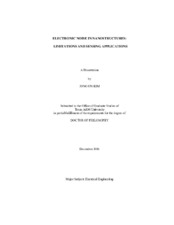| dc.description.abstract | Nanostructures are nanometer scale structures (characteristic length less than 100 nm) such as
nanowires, ultra-small junctions, etc. Since nanostructures are less stable, their characteristic
volume is much smaller compared to defect sizes and their characteristic length is close to
acoustical phonon wavelength. Moreover, because nanostructures include significantly fewer
charge carriers than microscale structures, electronic noise in nanostructures is enhanced
compared to microscale structures. Additionally, in microprocessors, due to the small gate
capacitance and reduced noise margin (due to reduced supply voltage to keep the electrical field
at a reasonable level), the electronic noise results in bit errors. On the other hand, the enhanced
noise is useful for advanced sensing applications which are called fluctuation-enhanced sensing.
In this dissertation, we first survey our earlier results about the limitation of noise posed on
specific nano processors. Here, single electron logic is considered for voltage controlled logic
with thermal excitations and generic shot noise is considered for current-controlled logic.
Secondly, we discuss our recent results on the electronic noise in nanoscale sensors for SEnsing
of Phage-Triggered Ion Cascade (SEPTIC, for instant bacterial detection) and for silicon
nanowires for viral sensing. In the sensing of the phage-triggered ion cascade sensor,
bacteriophage-infected bacteria release potassium ions and move randomly at the same time;
therefore, electronic noise (i.e., stochastic signals) are generated. As an advanced model, the
electrophoretic effect in the SEPTIC sensor is discussed. In the viral sensor, since the
combination of the analyte and a specific receptor located at the surface of the silicon nanowire
occurs randomly in space and time, a stochastic signal is obtained. A mathematical model for a
pH silicon nanowire nanosensor is developed and the size quantization effect in the nanosensor
is also discussed. The calculation results are in excellent agreement with the experimental results
in the literature. | en |


